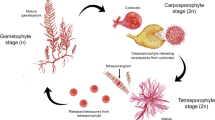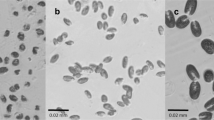Abstract
To resolve “the supply problem” in sponge-derived drug development and other biotechnological applications, current research is exploring the possibility of obtaining an alternative sustainable supply of sponge biomass through intensive aquaculture of sponges utilizing artificial seed rearing. This study aimed to investigate the technology of early juvenile sponge cultivation under controlled conditions. The effects of food, temperature, water flow, and light on the growth and survival of early juveniles of the marine sponge Hymeniacidon perlevis were examined. The concentrations of four types of food elements [microalgae (Isochrysis galbana), photosynthetic bacteria (Rhodopseudomonas), Fe3+ (FeCl3), and Si (Na2SiO3)] were investigated for early H. perlevis juvenile growth. Interestingly, temperature changes have striking effects on juvenile growth. Juvenile sponges grow faster when they are shifted to higher temperatures (18°C to 23°C) than when they are shifted to lower temperatures (18°C to 4°C to 23°C) or kept at a constant temperature (18°C). Periodic water flow and light cycles favor early juvenile sponge growth. Light was found to be a key factor in the color loss of early H. perlevis juveniles. Overall, size (area) increased as much as 29 times for H. perlevis juveniles under the tested controlled conditions.







Similar content being viewed by others
References
Caralt S, Otjens H, Uriz MJ, Wijffels RH (2007) Cultivation of sponge larvae: settlement, survival and growth of juveniles. Mar Biotechnol 9(5):592–605
Dong YW, Dong SL, Tian XL, Zhang MZ, Wang F (2005) Effect of water temperature on growth, respiration and body composition of young sea cucumber Apostichopus japonicus. Journal of Fisheries Science of China 12:33–37. (in Chinese)
Duckworth AR, Battershill CN (2003) Developing farming structures for production of biologically active sponge metabolites. Aquaculture 217:139–156
Ereskovsky AV (2000) Reproduction cycles and strategies of the cold-water sponges Halisarca dujardini (Demospongiae, Halisarcida), Myxilla incrustans and Iophon piceus (Demospongiae, Poecilosclerida) from the White Sea. Biol Bull 198:77–87
Fosså SA, Nilsen AJ (1996) Korallenriff-Aquarium, band5. Einzellige organismen, schwämme, marine würmer und weichtiere im korallenriff und für das korallenriff-aquarium. In: Osinga R, Tramper J, Wijffels RH (1999) Cultivation of marine sponges. Mar Biotechnol 1:509–532
Fromont J, Garson M (1999) Sponge bleaching on the west and east coasts of Australia. Coral Reefs 18:340
Fry WG (1971) The biology of larvae of Ophlitaspongia seriata from two Nord Wales populations. In: Maldonado M (2006) The ecology of the sponge larva. Can J Zool 84:175–194
Fu WT, Sun LM, Zhang XC, Zhang W (2006) Potential of the marine sponge Hymeniacidon perlevis as a bioremediator of pathogenic bacteria in integrated aquaculture ecosystems. Biotechnol Bioeng 93:1112–1122
García-Esquivel Z, Montes-Magallón S, González-Gómez MA (2007) Effect of temperature and photoperiod on the growth, feed consumption, and biochemical content of juvenile green abalone, Haliotis fulgens, fed on a balanced diet. Aquaculture 262:129–141
Kim JK, Lee BK (2000) Mass production of Rhodopseudomonas palustris as diet for aquaculture. Aquaculture 23:281–293
Kobayashi M, Kurata SI (1978) The mass culture and cell utilization of photosynthetic bacteria. Process Biochem 13:27–30
Leighton DL, Byhower MJ, Kelly JC, Hooker GN, Morse DE (1981) Acceleration of development and growth in young green abalone (Haliotis fulgens) using warmed effluent seawater. J World Maric Soc 12:170–180
Maldonado M (1998) Do chimeric sponges have improved chances of survival? Mar Ecol Prog Ser 164:301–306
Maldonado M (2006) The ecology of the sponge larva. Can J Zool 84:175–194
Maldonado M, Young CM (1996) Effects of physical factors on larval behavior, settlement and recruitment of four tropical demosponges. Mar Ecol Prog Ser 138:169–180
Maldonado M, Uriz MJ (1998) Microrefuge exploitation by subtidal encrusting sponges: patterns of settlement and postsettlement survival. Mar Ecol Prog Ser 174:141–150
Mariani S, Uriz MJ, Turon X (2000) Larval bloom of the oviparous sponge Cliona viridis: coupling of larval abundance and adult distribution. Mar Biol 137:783–790
Meeren TV, Jensen AM, Pickova J (2007) The effect of green water and light intensity on survival, growth and lipid composition in Atlantic cod (Gadus morhua) during intensive larval rearing. Aquaculture 265:206–217
Mercurio M, Corriero G, Gaino E (2007) A 3-year investigation of sexual reproduction in Geodia cydonium (Jameson 1811) (Porifera, Demospongiae) from a semi-enclosed Mediterranean Bay. Mar Biol 151:1491–1500
Osinga R, Kotterman M (2006) Maintaining marine sponges in tanks: effects of feeding and iron. In: 7th International Sponge Symposium: Biodiversity, Innovation, Sustainability, Brazil, Book of Abstracts, 28 p
Osinga R, Beukelaer PB, Meijer EM, Tramper J, Wijffels RH (1999a) Growth of the sponge Pseudosuberites (aff.) andrewsi in a closed system. J Biotechnol 70:155–161
Osinga R, Tramper J, Wijffels RH (1999b) Cultivation of marine sponges. Mar Biotechnol 1:509–532
Palazzi R, Richard J, Bozzato G, Zanella L (2006) Larval and juvenile rearing of common sole (Solea solea L.) in the Northern Adriatic (Italy). Aquaculture 255:495–506
Reincke T, Barthel D (1997) Silica uptake kinetics of Halichondria panicea in Kiel Bight. Mar Biol 129:591–593
Reitan KI, Rainuzzo JR, Øie G, Olsen Y (1997) A review of the nutritional effects of algae in marine fish larvae. Aquaculture 155:207–221
Ronquillo JD, McKinley RS (2006) Developmental stages and potential mariculture for coastal rehabilitation of endangered Pacific angelwing calm, Pholas orientalis. Aquaculture 256:180–191
Steindler L, Beer S, Ilan M (2002) Photosymbiosis in intertidal and subtidal tropical sponges. Symbiosis 33:263–273
Turon X, Tarjuelo I, Uriz MJ (1998) Growth dynamics and mortality of encrusting sponge Crambe crambe (Poeciloscerida) in contrasting habitats: correlation with population structure and investment in defense. Funct Ecol 12:631–639
Tzovenis I, Pauw ND, Sorgeloos P (2003) Optimisation of T-ISO biomass production rich in essential fatty acids. I. Effect of different light regimes on growth and biomass production. Aquaculture 216:203–222
Vicente VP (1990) Response of sponges with autotrophic endosymbionts during the coral-bleaching episode in Puerto Rico. Coral Reefs 8:199–202
Wilkinson CR, Vacelet J (1979) Transplantation of marine sponges to different conditions of light and current. In: Osinga R, Tramper J, Wijffels RH (1999) Cultivation of marine sponges. Mar Biotechnol 1:509–532
Yoseda K, Dan S, Sugaya T, Yokogi K, Tanaka M, Tawada S (2006) Effects of temperature and delayed initial feeding on the growth of Malabar grouper (Epinephelus malabaricus) larvae. Aquaculture 256:192–200
Yu DX, Song BX (1999) Variation of survival rates and growth characteristics of pond culture juvenile Apostichopus japonicus. Journal of Fisheries Science of China 6:109–110. (in Chinese)
Zhang XY (2003) Establishment and optimization of in vitro cultivation of sponge primmorph: aggregation, growth and metabolism. Ph.D. dissertation, pp 111–113 (in Chinese)
Zhao QY, Zhang W, Jin MF, Yu XJ, Deng MC (2005) Formulation of a basal medium for primary cell culture of the marine sponge Hymeniacidon perleve. Biotechnol Prog 21(3):1008–1012
Acknowledgements
The authors are grateful for the financial support from the Hi-Tech Research and Development Program of China (2006AA09Z435), the Innovation Fund from the Dalian Institute of Chemical Physics, and the Innovative Key Project of the Chinese Academy of Sciences (KZCX2-YW-209). We thank Mr. Wei Dong Liu for providing the photosynthetic bacteria and Dr. K. Manmadhan for revising the manuscript.
Author information
Authors and Affiliations
Corresponding author
Rights and permissions
About this article
Cite this article
Xue, L., Zhang, W. Growth and Survival of Early Juveniles of the Marine Sponge Hymeniacidon perlevis (Demospongiae) Under Controlled Conditions. Mar Biotechnol 11, 640–649 (2009). https://doi.org/10.1007/s10126-009-9180-7
Received:
Accepted:
Published:
Issue Date:
DOI: https://doi.org/10.1007/s10126-009-9180-7




